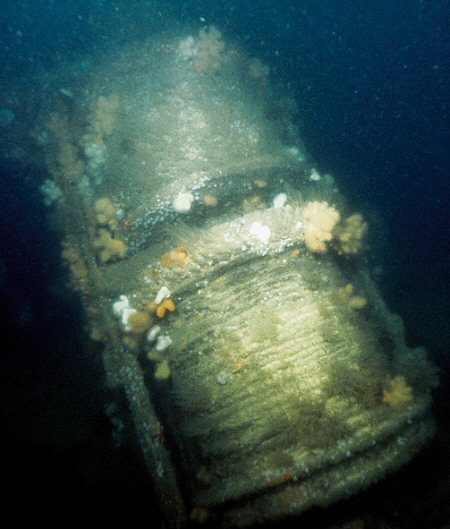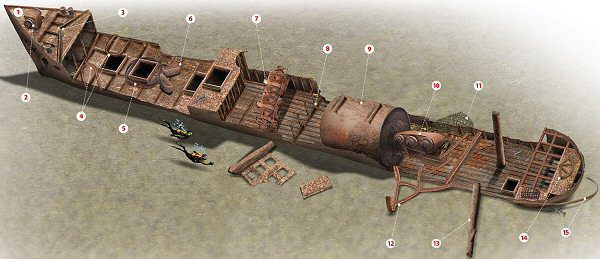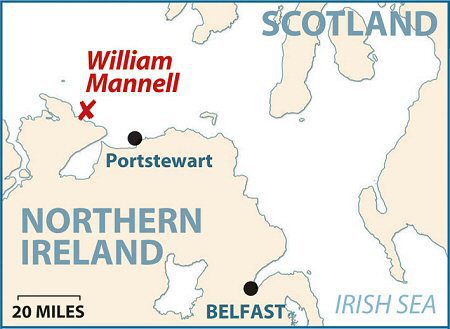This trawler served in the two world wars, as both escort and minesweeper, and is an attractive diving proposition in the fine visibility possible off the Donegal coast, says JOHN LIDDIARD. Illustration by MAX ELLIS
WE’RE OFF ACROSS the Irish Sea to Ireland for another wreck off Malin Head, the Fleetwood trawler William Mannell. Though the wreck lies off the Donegal coast, the most convenient diving access is from Portstewart in Northern Ireland.
Also read: Malin Head, Ireland’s wreck-diving magnet
When I dived the William Mannell, the shot was by the bow, so that is where our tour begins (1).

The bow lists slightly to port, with the port anchor missing and the starboard still in place. Some hull-plates above the waterline have rotted away, and the hull is covered in a mixture of yellow and white dead men’s fingers, anemones and hydroids; not an unusual covering for a wreck, but very pretty in the typically good visibility.
In the centre of the deck is a small anchor-winch (2). Behind this, the wooden decking has rotted away to leave only ribs preventing access inside. To either side are pairs of mooring bollards, then, spanning the deck, the raised V of a spray-deflector (3).
The William Mannell was built as an Admiralty Castle-class trawler, serving as an escort trawler in World War One, then as a minesweeper through WW2. Perhaps it was this service history that led to local rumours that the vessel was a mine victim from one or other of the two wars.
The Castle class was a prolific design, and the WW1 mine victim Benton Castle off Dartmouth featured in Wreck Tour 117 (October 2008). However, unlike the Benton Castle, the William Mannell survived both wars, and was with the Fleetwood fishing fleet when holed on the rocks near Glengad Head.
Refloating on the next tide, the Mannell sank slowly while under tow by the accompanying trawler Gava, so damage to the wreck is limited to that from the deep surge of Atlantic storms, and the hull is reasonably intact. The wreck lies with bow pointing towards the shore.
Behind the bow, the deck has dropped so that its port side is almost level with the seabed. Trawl gallows can be seen to either side of the deck (4), with the port gallows upright and the starboard collapsed across the deck.
Briefly turning back towards the bow, gaps between the upright supports for the deck provide a view inside, illuminated by light trickling in through numerous holes in the hull and deck.
An enormous lobster is rumoured to live in here, but I didn’t find it.
Turning aft again, a coil of cable on the deck is wrapped about the hatch-coaming to the hold (5). I suspect that this was the gear-hold, the fish-hold being further aft.

Next are a pair of cams along the centre of the deck (6), part of the net-handling gear, and a feature often found on trawler wrecks. These are followed by another hatch-coaming that could have been above the fish-hold.

The line of the deck is then interrupted by a step upwards and a bigger step downwards, where a section with a smaller hatch stands above the main level.
When the William Mannell was afloat, this would have been part of the main deck. However, most of the main deck has collapsed, leaving this section to stand above it. The trawl-winch (7) is tipped up further relative to the main deck, though not anywhere near far enough to be vertical. All the cables are wound, as the William Mannell was not fishing when she got into trouble.
Behind the trawl-winch is where the wheelhouse would have stood on a Castle-class trawler, raised slightly and partly back over the boiler. All that remains on the deck are a few upright sections of rib.
Just off the port side of the wreck, a flat section of crossed ribs (8) may have been part of the wheelhouse floor.

The single boiler (9) is intact except for a few holes in the outer casing, and fills the width of the hull.
The triple-expansion steam engine (10) is immediately behind the boiler and fallen further to port, mostly buried in debris.
A trawl-net (11) is tangled over the starboard side of the hull. This is a more recent nylon net, obviously fouled and lost on the wreck since the William Mannell sank, and not part of the original trawler’s fishing gear.
The aft trawl gallows have both fallen. The starboard gallows is on the seabed off the port side, while the port gallows (12) has simply fallen outward from its position at the edge of the deck.
Aft of the engine-room, another short section of deck supports an upright section of mast (13), with the upper part of the mast lying off the port side of the wreck.
As at the bow, this section of deck has dropped so that the stern stands slightly higher, with a stronger list to port.

The deck and some of the hull-plating has rotted away to leave a largely open framework. Like the bow, this is covered in dead men’s fingers, anemones and hydroids.
The steering quadrant (14), the source of the William Mannell’s woe, is aligned straight ahead. Off the stern of the wreck, the last item of wreckage is the curved stern rail (15), fallen to the seabed.
At only 29m down and just short of 38m long, most divers will have time to do a lazy couple of lengths of the Mannell without getting into too much decompression.
In typically clear visibility, relocating the shotline to ascend will be straightforward. However, hanging on at decompression depth in the groundswell could be both uncomfortable and risky, so a delayed SMB is recommended if longer stops are planned.
CARELESS AFTER 33 YEARS
WILLIAM MANNELL, trawler/minesweeper. BUILT 1916, SUNK 1949
NAMED AFTER A QUARTERMASTER’S MATE who served aboard HMS Victory with Nelson at Trafalgar, the William Mannell was built for the Royal Navy at Middlesbrough as a Castle-class steel trawler in 1916, and launched as an escort trawler on 2 June, 1917, writes Kendall McDonald.
She survived the war and was sold by auction in Milford Haven in 1920 to start her civilian life of fishing.
Registered in London with the fishing number LO370, the 276-ton steam trawler was 125ft long, with a beam of 23ft and a draught of 12ft. She was powered by a 61hp three-cylinder engine, and had her 12-pounder gun removed. But she had not finished with war.
On 10 June, 1940, the Admiralty requisitioned the William Mannell and converted her to a minesweeper, paying a monthly hire rate of £80 to her owners, the Boston Deep Sea Fishing & Ice Co of Fleetwood.
After surviving her second war, the Mannell returned to civilian fishing in November, 1945. Three years later she was sold to J Marr & Son of Fleetwood for £12,500, and fished the West of Scotland grounds under her skipper, Reuben J Melhuish, and 13 crew.
Out of Fleetwood with the trawler Gava in February, 1949, she was fishing the St Kilda grounds when gale warnings drove both trawlers to anchor in a small bay near Glengad Head, Donegal, on Ireland’s north coast.
While fishing, Captain Melhuish had found his steering gear jammed, but this had been easily freed by giving the wheel a small turn in the reverse direction.
By 4am the next day, 22 February, the weather seemed to have improved enough to start fishing again, and Captain Melhuish ordered the anchor raised. He then increased his speed from “slow” to “half ahead”, and put the wheel hard aport.
However, his steering had jammed again, and he made only a slight turn to port. Before he could stop the engine, the vessel hit the rocks, and stayed there listing to port, despite the engine being run at full astern for several minutes.
The crew abandoned ship into the boat, rowed to the Gava and got aboard. Two hours later, the captain and chief engineer went back to find the fish-hatch full of sea water, although the engine-room was dry.
At 12.15pm the Mannell refloated, listing to port, on the rising tide. The trawler was taking in water and down by the head, but the Gava attempted to tow her to a nearby beach.
At 3pm this bid ended when the waterlogged trawler listed violently to port and sank by the head in “14 fathoms of water”.
Captain Melhuish was heavily criticised by the Admiralty Court held in August 1949 for his “lack of seamanlike care”, because he had made no attempt to maintain steam and operate the pumps after stranding. His certificate was suspended for six months.
TOUR GUIDE
GETTING THERE: Norfolkline Irish Sea Ferry Services, Liverpool (Birkenhead) to Belfast, 0844 499 0007. From Belfast take the M2, A26 and A2 to Portstewart.
HOW TO FIND IT: GPS co-ordinates are 55 18.410N, 007 04.500W (degrees, minutes and decimals). The wreck lies across the tide with the bow towards shore
TIDES: Slack water is essential, and coincides with high or low water Belfast.
DIVING, AIR & ACCOMMODATION: Aquaholics, 0287 0832584.
QUALIFICATIONS: At a depth of 29m, the William Mannell is ideally suited for the average spread of qualifications on a club trip.
LAUNCHING: There is a public slip in the harbour at Portstewart.
FURTHER INFORMATION: Admiralty Chart 2811, Sleep Haven to Lough Foyle. Admiralty Chart 2798, Lough Foyle to Sanda Island including Rathlin Island. Shipwreck Index of Ireland, by Richard and Bridget Larn. Irish Wrecks Online by Randall Armstrong.
PROS: A pretty trawler that is easy to navigate in typically excellent visibility. An ideal wreck for divers recently qualified to this depth.
CONS: Even at slack water there can be a fair surge from a big groundswell.
DEPTH RANGE: 20-35m
Thanks to Richard Lafferty.
Appeared in DIVER May 2010


